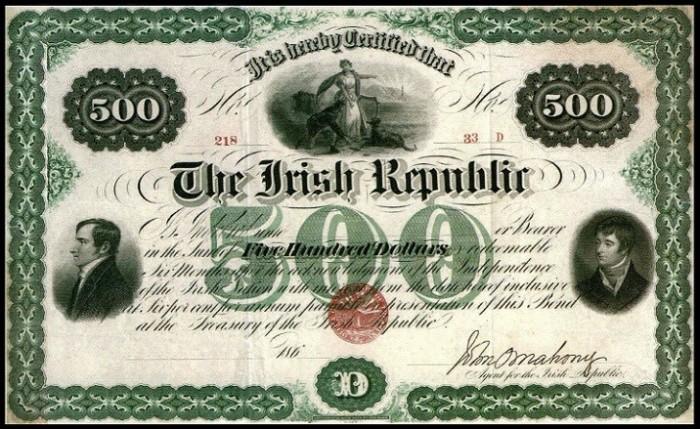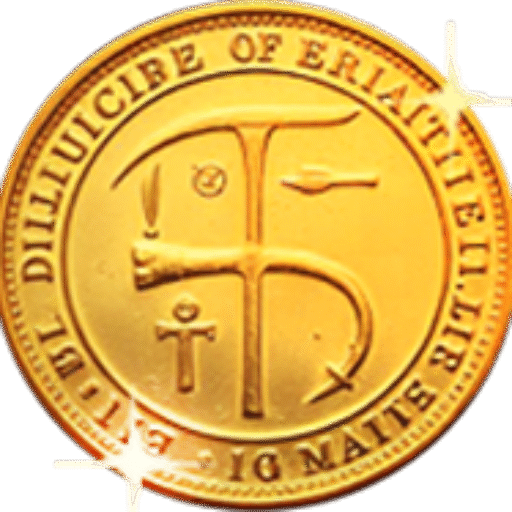Fenian Bonds: O’Mahony Issue, $500 (Robert Emmet & Lord Edward Fitzgerald)

Date: 1866
Fenian Bond 500 Dollars Unissued O’Mahony
Description:
Issued between 1866 and 1867, these are the first type of Fenian Bond from this period, entitled ‘The National Bond for the Irish Republic’ and signed by O’Mahony.
- The $500 Bond featured vignettes of Robert Emmet and Lord Edward Fitzgerald
- Printed by Continental Bank Note Printing Company, New York
- Size: 18 x 27.5cm
- Serial Number:
- Issued:
History of the O’Mahony Bonds:
Often called “Fenian” bonds, these large sheets of paper were issued by republican groups in the 19th and early 20th centuries to raise money for the cause of Irish freedom.
- The O’Mahony bonds were issued by one wing of the Fenians and were issued in the name of ‘The Irish Republic’.
- The Scanlon bonds were issued by another wing of the Fenians Party and were issued in the name of ‘The Republic of Ireland’.
- Most of the notes fall within the date range 1865-1867.
In 1866, the New York Times published a scathing article claiming that:
- People in Boston faced “unexpected difficulties” after questions arose about where people’s money was going when they purchased these bonds and just what it was being used for.”
- “thousands of those who contributed their hard earnings…now feel that they have been the victims of designing men and demand a legal investigation”.
The bonds themselves weren’t payable until after an Irish republic was established and the Fenians insisted that bond-holders knew full well this condition. As such, they claimed that:
- “Those who are still hoping to see the independence of Ireland realised contend that there has been no fraud practiced whatever.”
The newly-formed government upheld the original condition of the Fenian bond – they could be redeemed once an Irish republic had been established. Or in this case declared.
For 10 years – between June 1927 and October 1937 – there was an office operated by the now-independent Irish state at 117 Liberty Street, New York City where bond holders could redeem their bonds.
By 1973, the last Dáil Act relating to these bonds had expired and the New York office had closed. There were no longer arrangements in place for redeeming un-exchanged bonds.
- The final date was 30 June 1936.
John O’Mahony:
John O’Mahony, organiser of the Fenian Movement in America and head of its operations there, was born into a farming family in Kilbehenny, Co Limerick in 1816. He came from a family of strong farmers and was educated at a classical school in Co Cork and, later, in Trinity College Dublin – although he did not graduate with a degree. He was a classical (Greek and Latin) and Irish scholar, with a good knowledge of Hebrew and Sanskrit. He also possessed sufficient French to write articles relating to Ireland in French newspapers during his exile there.
In 1857, he published a translation of Geoffrey Keating’s Foras Feasa ar Éirinn – a story of Ireland from the creation of the world to the coming of the Normans. It was originally written by Geoffrey Keating – an Old English Catholic priest from south County Tipperary. It was completed c. 1634. Although his book received good reviews, its sale was banned in the United Kingdom of Great Britain & Ireland at the time.
O’Mahony’s father and grandfather had both taken part in the famed failure of the 1798 Rebellion and O’Mahony – being a man of action, rather than a literary academic, wished to follow their footsteps and liberate Ireland.
- As a young man, he joined the O’Connell Repeal Movement
- He later followed Smith O’Brien and helped him form the Young Ireland Party in 1845
- O’Mahony then took part in another doomed rebellion in 1848 – specifically, the abortive rising at Ballingarry.
- Upon the arrest of O’Brien, O’Mahony went on the run and waged a guerrilla war against the British Army and its Irish Militias in the hills around the Kilkenny and Waterford borders for several months.
- He then fled to France where, despite his skills, he lived a life of poverty in Paris for several years, before emigrating to America.
In 1854, he joined Mitchel in New York and, while working on his translation of Keatings history, he assisted various American-Irish organisations – including the Irish Emigrant Aid Association. His thirst for rebellion was renewed when he met John Stephens and co-founded the Irish Republican Brotherhood (the IRB, or Fenians as they were also known) in 1858. It is said that by 1858, he was a colonel in the American Army and that he resigned his commission in order to spend more time to the IRB.
It is said that O’Mahony sent between $40,000 and $80,000 to Ireland to buy weapons for the Fenian Rising there in 1867 but he did not take part in it. Some say he did not take part in any of the Fenian Raids in Canada between 1866 and 1871, whereas other sources say he led the Fenian raid at Campobello Island, New Brunswick in April 1866.
- There were five Fenian raids of note in Canada
- All of them ended in failure
- They divided the Irish-Canadian community along sectarian lines
- This weakened support for the Irish Republican movement there
- They also sapped the energy of the Irish-American movement
O’Mahony devoted his latter days to literary pursuits and died in 1877, aged 61. His remains were brought back to Ireland for burial at Glasnevin Cemetery. Other IRB leaders buried there include John Devoy, James Stephens and Jeremiah O’Donovan Rossa – the latter immortalised by Pearse in his famous graveside speech on 1st August 1915.
“They think that they have pacified Ireland. They think that they have purchased half of us and intimidated the other half. They think that they have foreseen everything, think that they have provided against everything; but the fools, the fools, the fools! – they have left us our Fenian dead, and while Ireland holds these graves, Ireland unfree shall never be at peace.”
O’Mahony was given a state funeral in New York before his body was sent back to Ireland, via the steamer “Dakota”. According the “Irish-American” newspaper,
“The body of Colonel O’Mahony laid in state at the armory of the 69th Regiment until the morning of the 13th inst., and was viewed there by thousands of our citizens, the throng at times being so great as to entirely block up all the approaches to the building.”
The Hearse, containing the coffin drawn by four coal-black horses with sable trappings and surrounded by the Pall-bearers. The route was down Broadway to Canal street, and up West street to Pier 46, at which the steamship “Dakota” was lying, with steam up and ready to start. The wharf of the Williams & Guion Company was dressed with Irish and American flags, floating at half-staff; and, as soon as the funeral cortege came in sight, the ship’s bell began to toll, and continued until the coffin had been transferred to the place prepared for it in the after hatch.
O’Mahony was also given a republican funeral in Ireland, where his body lay in state in the Mechanics’ Institute (Abbey Street, Dublin) after Paul Cardinal Cullen, archbishop of Dublin, an anti-Fenian, refused it admission to the procathedral; his funeral procession, to Glasnevin Cemetery on March 4, 1877, drew a crowd of more than 70,000 nationalists of all sorts. Charles Kickham delivered O’Mahony’s funeral oration.
- John O’Mahony’s grave at Glasnevin:
- There are occasional tours of the IRB graves organised by the Glasnevin Trust – check their website for details.
- The Glasnevin Cemetery Museum also hosts other more frequent tours and these are listed here.

At Malvern Hill, the 69th led the brigade in a charge against advancing Southern troops. The 69th forced the retreat of the famed Confederate Irish Regiment Louisiana Tigers, an event for which General Robert E. Lee gave the regiment its nickname, “The Fighting 69th”.
The 69th fought at the following American Civil War battles:
- Bull Run
- The Seven Days
- Malvern Hill and Antietam
- Fredericksburg, Chancellorsville and Gettysburg
- Petersburg & Appomattox
It is not certain whether O’Mahony actually fought in any of these battles, or if he was a recruiting officer based in New York and an organiser of Irish-American immigrants. With the rank of colonel, he was clearly a senior officer in a regiment that sustained high casualties at many famous battles. Towards the end of the war, a re-constituted 69th was on guard duty at Camp Chemung, Elmira, N.Y. (a Confederate Prison) and O’Mahony new recruits seem to have been posted there.









This piece offers a compelling look at the history of the Fenian bonds and the complex life of John O’Mahony. The bond’s connection to the fight for Irish independence and their eventual redemption process is particularly noteworthy.
The details about O’Mahony’s life, from his scholarly pursuits to his involvement in various rebellions, paint a vivid picture of a dedicated and driven individual. His commitment to Irish freedom, spanning continents and decades, is truly remarkable. The inclusion of his funeral orations and burial details adds a poignant touch to the narrative.